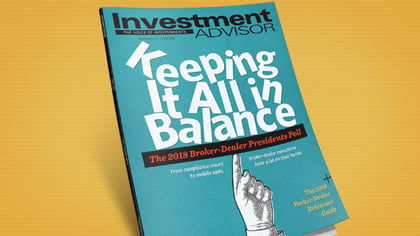It’s true. Independent broker-dealers may have gotten a break.
The Department of Labor’s fiduciary rule has been vacated by the 5th Circuit Court of Appeals and is meeting other legal challenges.
Still, BNY Mellon’s Pershing Advisory Solutions CEO Mark Tibergien points out there are plenty of other complexities confronting the IBD industry. Consider these shifts in the landscape: Brand-name retail firms pushing their advisory solutions with aggressive marketing; consolidators receiving millions in capital to grow market share; dominant regional firms winning the talent wars; and large firms negotiating more effectively with vendors and service providers for better pricing and greater access to solutions.
Forty-four IBD leaders shared their views on what the top hurdles are for their firms and advisors in this year’s Presidents Poll, which included a variety of new questions concerning hot topics like Bitcoin and cybersecurity. In the area of technology, for instance, the number of issues is considerable. Cambridge Investment Research CTO Nick Graham says the trends he’s focused on include built-in security, integration and mobility, and multi-faceted integration. We invite you to read on for details on the many issues that industry executives are most anxious about and how confident they are in the future of this dynamic business model.
We first asked industry executives about the headwinds they face. In terms of short-term issues, nearly 36% of IBD presidents say improving and funding their technology and platforms is what keeps them up at night.
They say their top concerns include doing and spending more on compliance and regulatory issues — 31% in the short term and close to 27% in the long term — as well as coping with fee compression and industry consolidation (20% for the short term and 25% for long term).
Just how many firms are closing or being merged with others due to cost and related challenges? According to the Financial Industry Regulatory Authority, the number of broker-dealers stood at 3,726 in 2017 — down from 4,999 in 2007. This represents the disappearance of one in four broker-dealers over the past decade. During the same period, the number of registered representatives tracked by FINRA fell to 630,010 from 672,700.
“There will be fewer advisors and fewer broker-dealers in the future,” said James Poer, president and CEO of Kestra Financial, at an industry conference. In his view, the IBDs that aggressively invest in people, technology and related resources “are going to be the winners.” For advisors, their top concern is business growth, according the IBD executives. Forty percent say adding new clients and assets is their reps’ top short-term challenge. That figure jumps to 50% when executives are asking about advisors’ main long-term concerns.
Though the demand for financial advice is strong, getting a steady supply of new clients and assets is not guaranteed. As Tibergien has written: “Advisors of the future likely will absorb costs clients typically pay, including fund expenses, custodial charges and trading fees.” He also suggests advisors plan strategies now to remain competitive: “Firms that present themselves to the market as reliable, relevant and responsible enterprises likely will prevail. Advisors who do not take control of their identity will find it harder to compete with more assertive contemporaries.”
Regulation Issues
As for regulation and compliance, the majority of IBDs — about 80% — are either taking a wait-and-see approach to the DOL’s fiduciary rule or are shifting resources away from planning for the rule and are monitoring developments. A minority, roughly 20%, say there are moving forward to comply with it.
Raymond James Chairman & CEO Paul C. Reilly discussed the uncertainty on an earnings call in late April: “We think [DOL’s appeal of a First Circuit rule vacating the rule is] unlikely, but who knows. And there may be other challenges by other groups; but we think most likely that rule will disappear, but you never know.”
LPL Financial CEO Dan Arnold in early May made similar remarks when explaining the IBD’s anticipated launch of a Mutual Fund Only (MFO) platform. The firm has been “trying to time that relative to the regulatory change. And hence as the date moved around, we would tend to alter and adjust the rollout plans associated with it, certainly with the DOL rule likely being vacated and now the [Securities and Exchange Commission] taking up the rule-making process.”
Arnold, on a call with equity analysts, added: “Again, we’re on pause to try to figure out and get better clarity [regarding] the SEC’s rule itself, and then ultimately the timing of it. … So, it’s a bit of a wait and see to get more information and insight around the rule itself before we can make those determinations.”
Most IBD executives aren’t overly negative about the SEC’s proposed fiduciary rule — with 62% saying it will have a minor impact on compliance operations and costs, but not put most BDs out of business. Still, 24% believe it will have a significant impact on the industry, and 13% say it will cause confusion.
Turning to FINRA audits, top concerns include those affecting share classes, nearly 39%; along with outside business activities, 18%, and “selling away,” 18%. The departure of more large firms from the Protocol for Broker Recruiting is seen by nearly 58% of IBD presidents as having little to no impact and about 33% as having a somewhat negative impact.
Adding New Products Like Cryptocurrencies









 May 29, 2018 at 06:10 AM
May 29, 2018 at 06:10 AM











